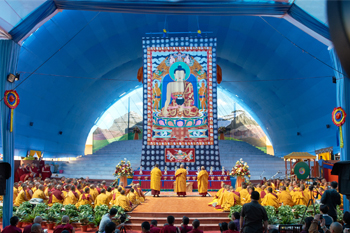21 February, 2012 Bodhgaya
This morning, in a two-hour ceremony at the Monlam Pavilion, a magnificent appliqué thangka of Buddha Shakyamuni, flanked by the bodhisattvas Maitreya andManjusri, was unfurled and consecrated. It had taken six months, from June to December 2011, to make the thangka, measuring 20 feet by 30 feet. It was constructed in a prayer hall at Gyuto Monastery, the Gyalwang Karmapa’s current residence in North India, under the close supervision and direction of the Gyalwang Karmapa himself, who visited the project at least once a day. On completion, the thangka was carefully packed into a specially constructed metal cylinder and brought across India by lorry from the north eastern Himalayan foothills to Bodhgaya on the central western plains.
Rehearsals for the ceremony, began just after 7.00am and finished at 10.00am; patiently the Gyalwang Karmapa instructed everyone in precisely what to do and when. The ceremony itself began at 10.15am when the rolled-up thangka entered the Monlam Pavilion, in a formal procession of incense bearers, gyalin and auspicious banners. It was carried down the central aisle by the five young men who had helped Master Tailor Tenzin Gyaltsen make it. They were dressed alike in traditional Tibetan clothing, white shirts, dark blue chubas, red sashes and black leather boots. The thangka was placed carefully in position on the altar at the centre of the stage, above a row of eight white butter sculptures and a lower row of offering bowls, and the consecration ceremony began.
This impressive ceremony was a reminder of the literary and musical talent that the Gyalwang Karmapa has displayed since his teens. He compiled the prayers specially for the event, and was involved at all stages of the composition of the accompanying music – a collaborative work between the Gyalwang Karmapa, his chanting masters and Taiwanese music professor Ying Hwang-Yi. Traditionally, in Tibetan ritual, certain instruments are used for particular rituals. This musical arrangement, however, employs every single ritual instrument, from the smallest cymbals to the largest horns, a first in the history of Tibetan ritual music. And, although the melodies for the chants were traditional, the rhythms were altered. The Gyalwang Karmapa’s vision was for the music to embody all four activities: pacifying, enriching, magnetizing and wrathful. Meditative musical interludes were interspersed between the sections of prayers.
The thangka had been securely tied to two ropes suspended from the domed ceiling of the pavilion, and, forty-five minutes into the ceremony, it was carefully hoisted to the rhythmic clash of a single set of cymbals. Concealed within a cluster of rinpoches, Gyalwang Karmapa could be seen directing this critical stage, beating time with his hands. The audience gazed awe-struck as the beauty and magnificence of this huge brocade image was revealed. But the face of the Buddha remained hidden by a covering of golden silk. The music and prayers continued, then, slowly, the covering was lifted. As the serene face of the Buddha was revealed, many of those watching began to cry. It was an overwhelmingly powerful and profound experience of thongdrol –liberation on seeing– the dynamic action of a sacred object which can plant the seeds of liberation in the mindstreams of those who beheld it.
The consecration ceremony continued with offerings. Gyalwang Karmapa donned his golden brocade Gampopa hat to make the mandala offering, assisted by Jamgon Kongtrul Rinpoche. He then gave a short talk in which he traced the history of such thangkas back to the Fourth Karmapa, commented on the auspiciousness of such an event at the sacred site of Bodhgaya on New Year’s Eve, and requested everyone to make sincere aspirations.
After the ceremony had concluded with aspiration and dedication prayers, the offering of khatags to the thangka and throwing rice for auspiciousness, the Gyalwang Karmapa called up the Master Tailor Tenzin Gyaltsen and his five assistants. Placing long, silk khatags around their necks, he thanked them for the great efforts they had made in order to complete the project.
At midday, the Gyalwang Karmapa, followed by Jamgon Kongtrul Rinpoche and Gyaltsap Rinpoche, left the stage, and the audience was able to come forward to offer their own prostrations and khatags.
The thangka is part of the Gyalwang Karmapa’s plan to revitalize the 600-year old tradition which originated when the Fourth Karmapa, Rolpe Dorje (1340 – 1383), made the first brocade thangka- of Buddha Shakyamuni with the bodhisattvasMaitreya and Manjusri – in Hor Yul, Mongolia. He was prompted to make the thangka after one of his students dreamt of a Buddha image 100 metres tall. According to historical records, this original thangka survived until the time of the Tenth Karmapa Chöying Dorje (1604-1674), when, ironically, it was destroyed by the Mongolian army which had invaded Tibet. The Seventeenth Karmapa has said that not only is it auspicious to revive this tradition at the time of the 900th birth anniversary of the First Karmapa Dusum Khyenpa, but also making a giant thangka can generate great merit which could be of collective benefit, especially for the welfare of Tibetans at this difficult time.
Gyalwang Karmapa envisages this thangka as merely the first stage; in future he hopes to commission one which is ten times bigger than this one, one that will be a hundred metres high.



